

Compact Muon Solenoid
LHC, CERN
| CMS-MUO-22-001 ; CERN-EP-2023-205 | ||
| Muon identification using multivariate techniques in the CMS experiment in proton-proton collisions at $ \sqrt{s}= $ 13 TeV | ||
| CMS Collaboration | ||
| 5 October 2023 | ||
| JINST 19 (2024) P02031 | ||
| Abstract: The identification of prompt and isolated muons, as well as muons from heavy-flavour hadron decays, is an important task. We developed two multivariate techniques to provide highly efficient identification for muons with transverse momentum greater than 10 GeV. One provides a continuous variable as an alternative to a cut-based identification selection and offers a better discrimination power against misidentified muons. The other one selects prompt and isolated muons by using isolation requirements to reduce the contamination from nonprompt muons arising in heavy-flavour hadron decays. Both algorithms are developed using 59.7 fb$ ^{-1} $ of proton-proton collisions data at a centre-of-mass energy of $ \sqrt{s}= $ 13 TeV collected in 2018 with the CMS experiment at the CERN LHC. | ||
| Links: e-print arXiv:2310.03844 [hep-ex] (PDF) ; CDS record ; inSPIRE record ; Physics Briefing ; CADI line (restricted) ; | ||
| Figures | |

png pdf |
Figure 1:
Composition of the simulated $ \mathrm{t\bar{t}} $ sample used for training after muon preselection in terms of muon origin according to generator-level information. The composition is shown as a function of $ p_{\mathrm{T}} $ (left) and $ \eta $ (right). The last bin on the left figure includes events with $ p_{\mathrm{T}} > $ 100 GeV. |
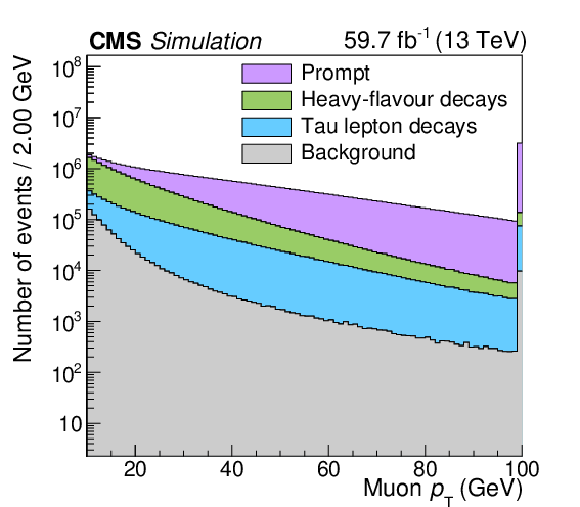
png pdf |
Figure 1-a:
Composition of the simulated $ \mathrm{t\bar{t}} $ sample used for training after muon preselection in terms of muon origin according to generator-level information. The composition is shown as a function of $ p_{\mathrm{T}} $. The last bin includes events with $ p_{\mathrm{T}} > $ 100 GeV. |
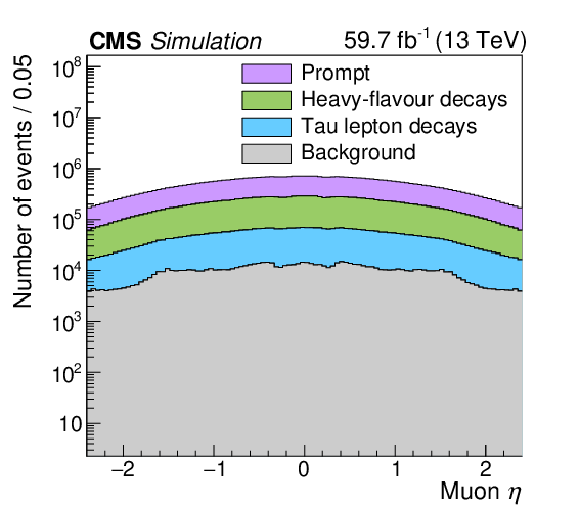
png pdf |
Figure 1-b:
Composition of the simulated $ \mathrm{t\bar{t}} $ sample used for training after muon preselection in terms of muon origin according to generator-level information. The composition is shown as a function of $ \eta $. |
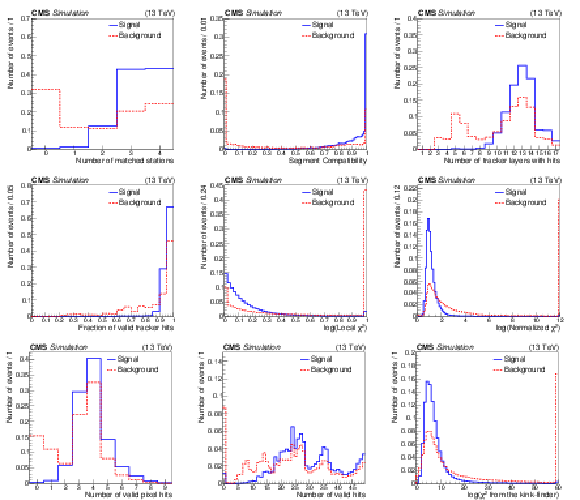
png pdf |
Figure 2:
Distribution in the simulated $ \mathrm{t\bar{t}} $ training sample of the number of matched stations (upper left), the segment compatibility (upper central), the number of tracker layers with hits (upper right), the fraction of valid tracker hits (middle left), the inner-standalone matching (middle central) and normalized $ \chi^2 $ of the muon fit (middle right), the number of valid pixel hits (lower left) and the total number of valid muon chamber hits (lower central), and the $ \chi^2 $ of the kink-finder algorithm (lower right), shown for signal and background, as defined in Section 5.1. The last bin of each distribution contains the overflow events. |

png pdf |
Figure 2-a:
Distribution in the simulated $ \mathrm{t\bar{t}} $ training sample of the number of matched stations, shown for signal and background, as defined in Section 5.1. The last bin contains the overflow events. |

png pdf |
Figure 2-b:
Distribution in the simulated $ \mathrm{t\bar{t}} $ training sample of the segment compatibility, shown for signal and background, as defined in Section 5.1. The last bin contains the overflow events. |

png pdf |
Figure 2-c:
Distribution in the simulated $ \mathrm{t\bar{t}} $ training sample of the number of tracker layers with hits, shown for signal and background, as defined in Section 5.1. The last bin contains the overflow events. |
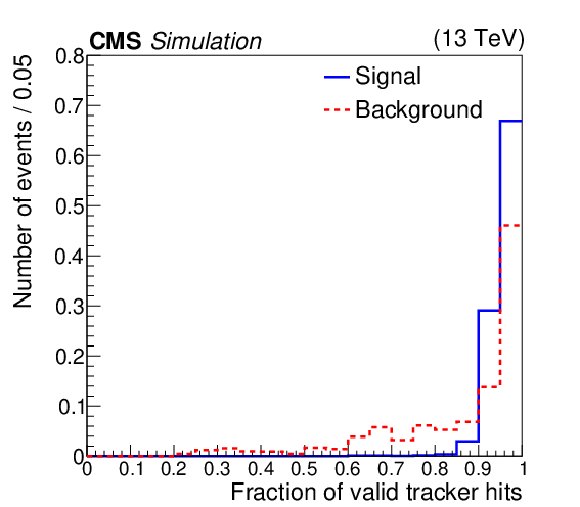
png pdf |
Figure 2-d:
Distribution in the simulated $ \mathrm{t\bar{t}} $ training sample of the fraction of valid tracker hits, shown for signal and background, as defined in Section 5.1. |
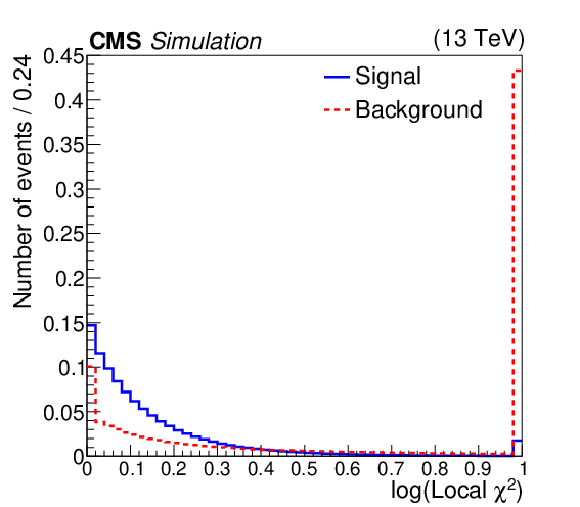
png pdf |
Figure 2-e:
Distribution in the simulated $ \mathrm{t\bar{t}} $ training sample of the inner-standalone matching, shown for signal and background, as defined in Section 5.1. The last bin contains the overflow events. |
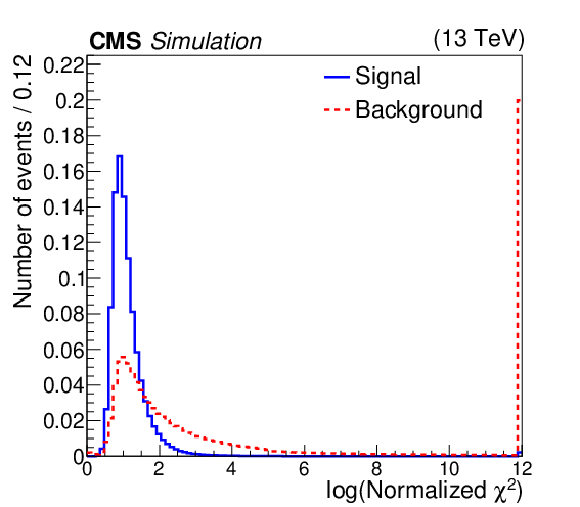
png pdf |
Figure 2-f:
Distribution in the simulated $ \mathrm{t\bar{t}} $ training sample of the normalized $ \chi^2 $ of the muon fit, shown for signal and background, as defined in Section 5.1. The last bin contains the overflow events. |
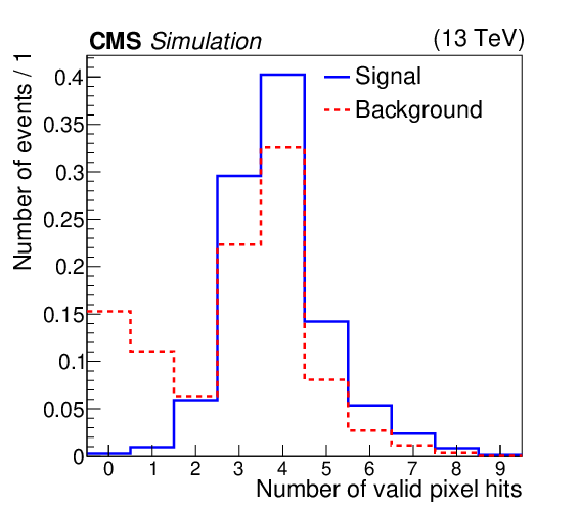
png pdf |
Figure 2-g:
Distribution in the simulated $ \mathrm{t\bar{t}} $ training sample of the number of valid pixel hits, shown for signal and background, as defined in Section 5.1. The last bin contains the overflow events. |
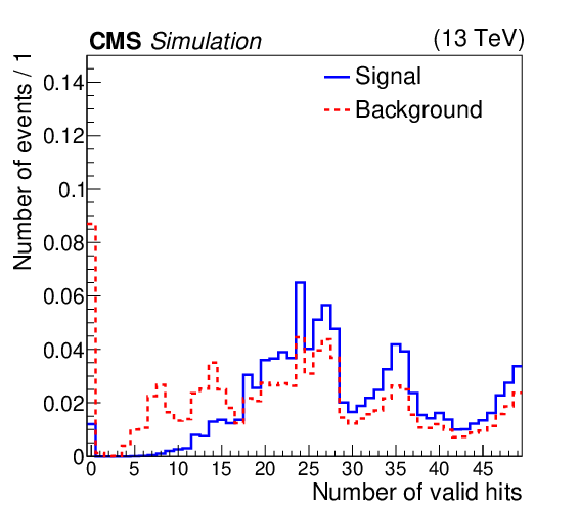
png pdf |
Figure 2-h:
Distribution in the simulated $ \mathrm{t\bar{t}} $ training sample of the total number of valid muon chamber hits, shown for signal and background, as defined in Section 5.1. The last bin contains the overflow events. |
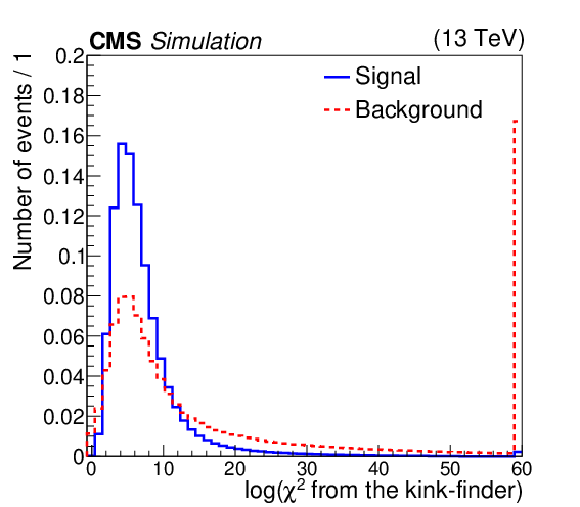
png pdf |
Figure 2-i:
Distribution in the simulated $ \mathrm{t\bar{t}} $ training sample of the $ \chi^2 $ of the kink-finder algorithm, shown for signal and background, as defined in Section 5.1. The last bin contains the overflow events. |
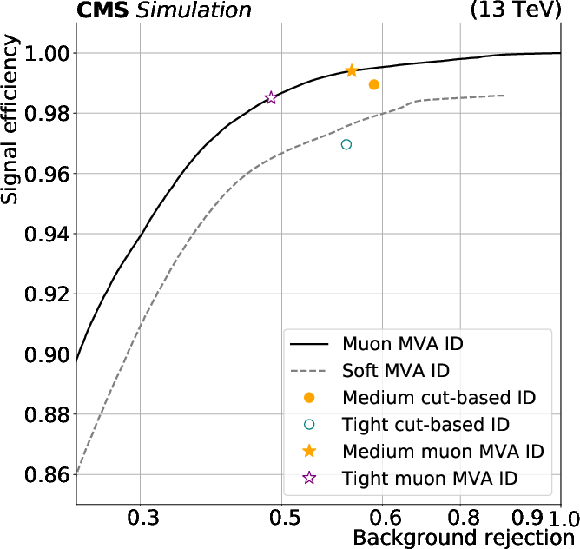
png pdf |
Figure 3:
The ROC curve for muons with $ p_{\mathrm{T}} > $ 10 GeV for the developed general muon MVA ID discriminator (black solid line) with the selected medium and tight WPs shown as orange solid and purple open stars, respectively. Orange solid and blue open points show the medium and tight WPs of the cut-based ID. The ROC curve of the soft MVA ID [11] is also shown (grey dashed line). |
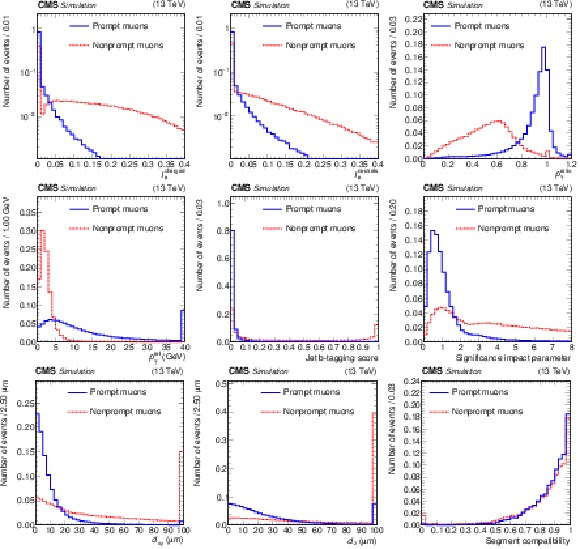
png pdf |
Figure 4:
Simulated distributions of the charged component (upper left) and the neutral component (upper central) of mini-isolation, the muon to jet $ p_{\mathrm{T}} $ ratio (upper right), the jet relative $ p_{\mathrm{T}} $ (middle left), the score of the associated DEEPJET B tagging algorithm (middle central), the significance of the impact parameter (middle right), the impact parameter in the transverse (lower left) and longitudinal (lower central) direction between the muon and the PV, and the segment compatibility (lower right) for prompt and nonprompt muons. |
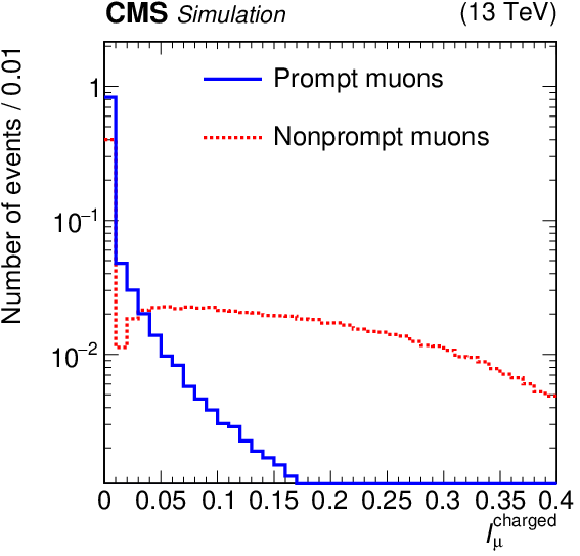
png pdf |
Figure 4-a:
Simulated distribution of the charged component of mini-isolation, for prompt and nonprompt muons. |

png pdf |
Figure 4-b:
Simulated distribution of the neutral component of mini-isolation, for prompt and nonprompt muons. |

png pdf |
Figure 4-c:
Simulated distribution of the muon to jet $ p_{\mathrm{T}} $ ratio, for prompt and nonprompt muons. |
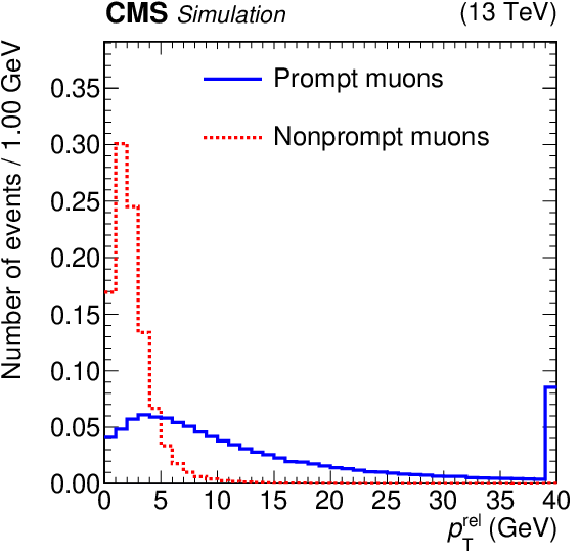
png pdf |
Figure 4-d:
Simulated distribution of the jet relative $ p_{\mathrm{T}} $, for prompt and nonprompt muons. |
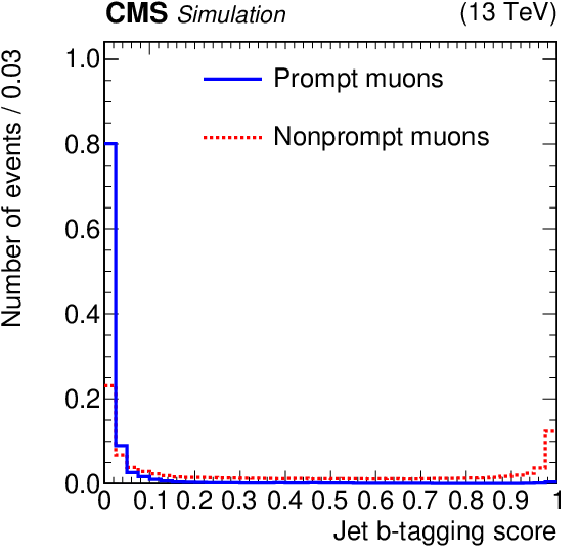
png pdf |
Figure 4-e:
Simulated distribution of the score of the associated DEEPJET B tagging algorithm, for prompt and nonprompt muons. |
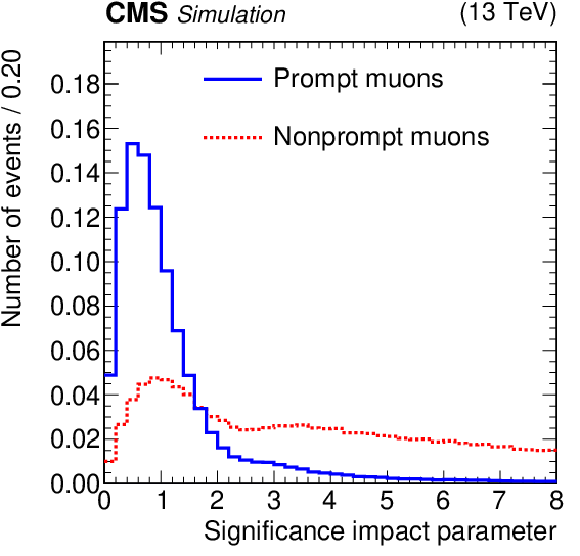
png pdf |
Figure 4-f:
Simulated distribution of the significance of the impact parameter, for prompt and nonprompt muons. |

png pdf |
Figure 4-g:
Simulated distribution of the impact parameter in the transverse longitudinal direction between the muon and the PV, for prompt and nonprompt muons. |
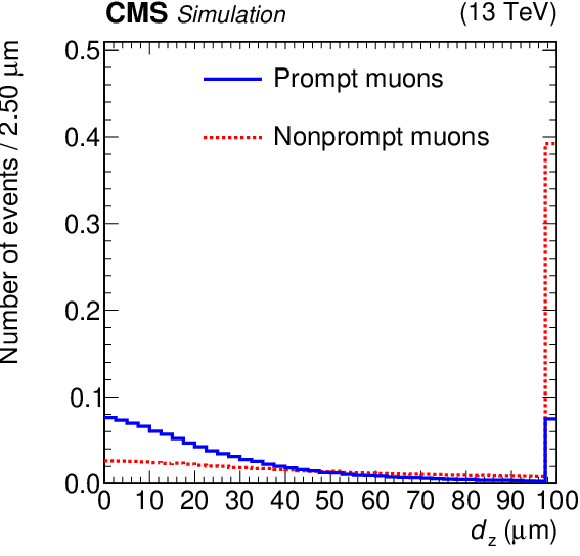
png pdf |
Figure 4-h:
Simulated distribution of the segment compatibility, for prompt and nonprompt muons. |

png pdf |
Figure 4-i:
Simulated distribution of the segment compatibility, for prompt and nonprompt muons. |
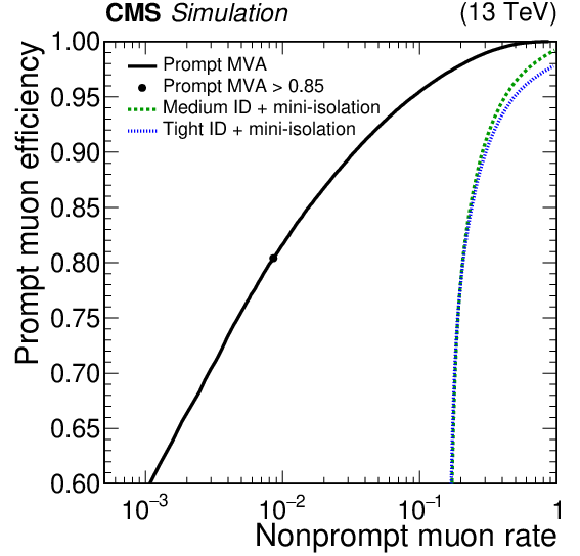
png pdf |
Figure 5:
ROC curve for the prompt-muon MVA, and for the tight and medium cut-based criteria together with requirements on mini-isolation. For a set of cuts on the different discriminators, the efficiency is shown as a function of proportion of nonprompt muons passing the WP selection. |

png pdf |
Figure 6:
Muon identification efficiency for the medium (upper) and tight (lower) WPs as a function of $ p_{\mathrm{T}} $ for muons with $ |\eta| < $ 0.9 (left) and $ |\eta| > $ 0.9 (right). Blue dots show the muon MVA ID performance both for the 2018 data set and DY simulation, whereas red triangles show the efficiency of the medium cut-based ID used during Run 2. The data to MC ratio is also shown. The efficiencies of the muon MVA ID are similar in both $ \eta $ regions. |
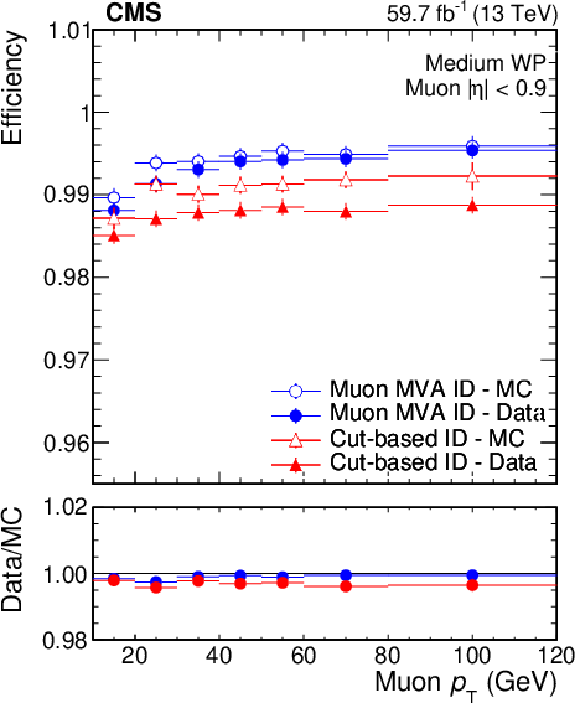
png pdf |
Figure 6-a:
Muon identification efficiency for the medium (upper) and tight (lower) WPs as a function of $ p_{\mathrm{T}} $ for muons with $ |\eta| < $ 0.9. Blue dots show the muon MVA ID performance both for the 2018 data set and DY simulation, whereas red triangles show the efficiency of the medium cut-based ID used during Run 2. The data to MC ratio is also shown. The efficiencies of the muon MVA ID are similar in both $ \eta $ regions. |

png pdf |
Figure 6-b:
Muon identification efficiency for the medium (upper) and tight (lower) WPs as a function of $ p_{\mathrm{T}} $ for muons with $ |\eta| > $ 0.9. Blue dots show the muon MVA ID performance both for the 2018 data set and DY simulation, whereas red triangles show the efficiency of the medium cut-based ID used during Run 2. The data to MC ratio is also shown. The efficiencies of the muon MVA ID are similar in both $ \eta $ regions. |

png pdf |
Figure 6-c:
Muon identification efficiency for the medium (upper) and tight (lower) WPs as a function of $ p_{\mathrm{T}} $ for muons with $ |\eta| < $ 0.9 (left) and $ |\eta| > $ 0.9 (right). Blue dots show the muon MVA ID performance both for the 2018 data set and DY simulation, whereas red triangles show the efficiency of the medium cut-based ID used during Run 2. The data to MC ratio is also shown. The efficiencies of the muon MVA ID are similar in both $ \eta $ regions. |
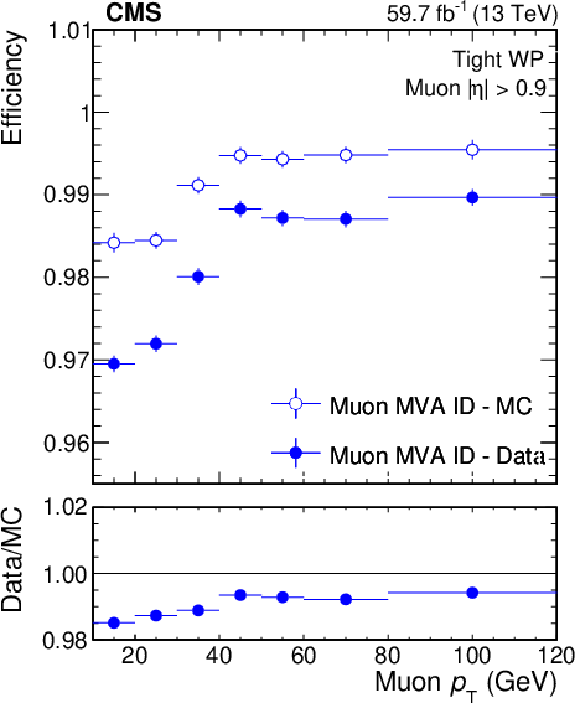
png pdf |
Figure 6-d:
Muon identification efficiency for the medium (upper) and tight (lower) WPs as a function of $ p_{\mathrm{T}} $ for muons with $ |\eta| < $ 0.9 (left) and $ |\eta| > $ 0.9 (right). Blue dots show the muon MVA ID performance both for the 2018 data set and DY simulation, whereas red triangles show the efficiency of the medium cut-based ID used during Run 2. The data to MC ratio is also shown. The efficiencies of the muon MVA ID are similar in both $ \eta $ regions. |
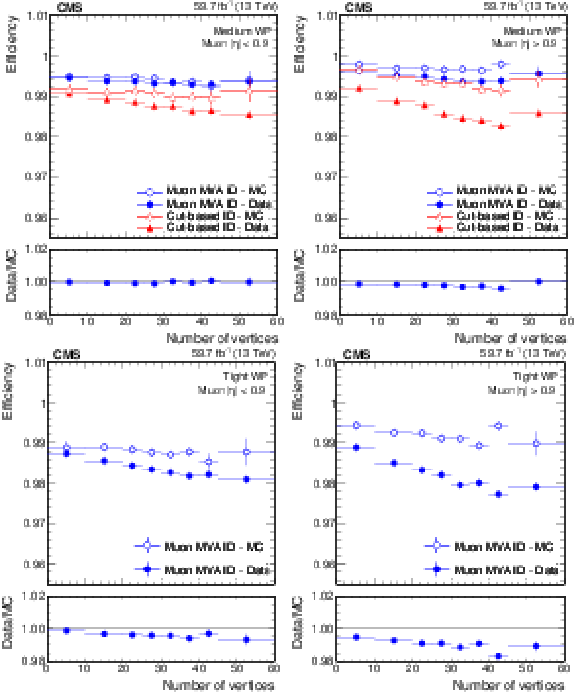
png pdf |
Figure 7:
Muon identification efficiency for the medium (upper) and tight (lower) WPs as a function of PU for muons with $ |\eta| < $ 0.9 (left) and $ |\eta| > $ 0.9 (right). Blue dots show the muon MVA ID performance both for the 2018 data set and DY simulation, whereas red triangles show the efficiency of the medium cut-based ID used during Run 2. The data to MC ratio is also shown. |
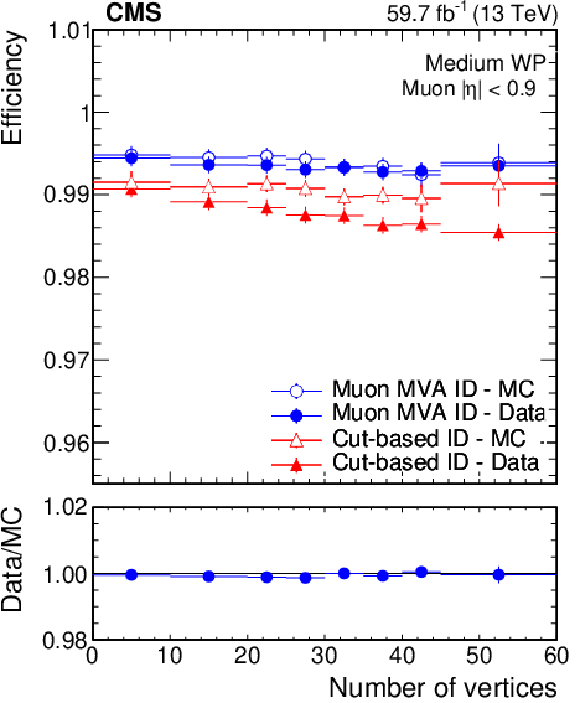
png pdf |
Figure 7-a:
Muon identification efficiency for the medium (upper) and tight (lower) WPs as a function of PU for muons with $ |\eta| < $ 0.9 (left) and $ |\eta| > $ 0.9 (right). Blue dots show the muon MVA ID performance both for the 2018 data set and DY simulation, whereas red triangles show the efficiency of the medium cut-based ID used during Run 2. The data to MC ratio is also shown. |
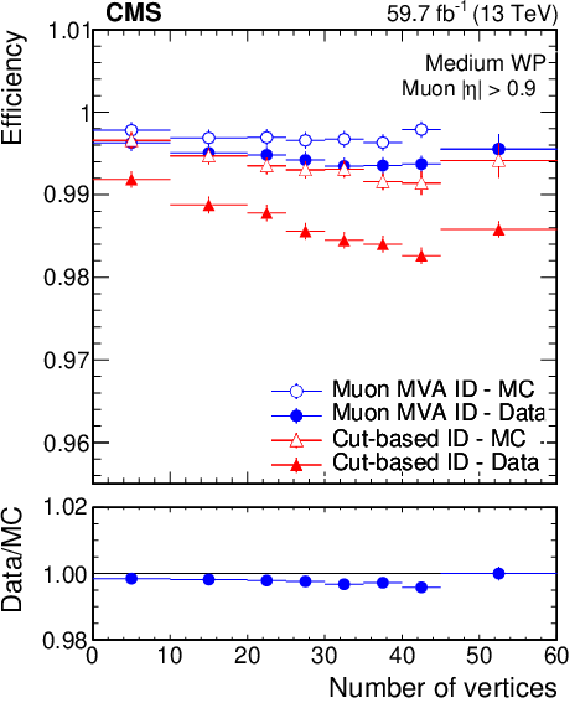
png pdf |
Figure 7-b:
Muon identification efficiency for the medium (upper) and tight (lower) WPs as a function of PU for muons with $ |\eta| < $ 0.9 (left) and $ |\eta| > $ 0.9 (right). Blue dots show the muon MVA ID performance both for the 2018 data set and DY simulation, whereas red triangles show the efficiency of the medium cut-based ID used during Run 2. The data to MC ratio is also shown. |

png pdf |
Figure 7-c:
Muon identification efficiency for the medium (upper) and tight (lower) WPs as a function of PU for muons with $ |\eta| < $ 0.9 (left) and $ |\eta| > $ 0.9 (right). Blue dots show the muon MVA ID performance both for the 2018 data set and DY simulation, whereas red triangles show the efficiency of the medium cut-based ID used during Run 2. The data to MC ratio is also shown. |
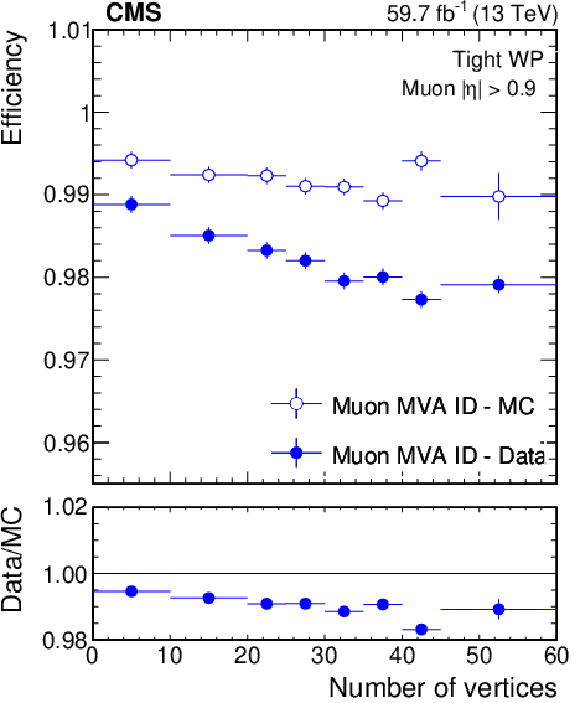
png pdf |
Figure 7-d:
Muon identification efficiency for the medium (upper) and tight (lower) WPs as a function of PU for muons with $ |\eta| < $ 0.9 (left) and $ |\eta| > $ 0.9 (right). Blue dots show the muon MVA ID performance both for the 2018 data set and DY simulation, whereas red triangles show the efficiency of the medium cut-based ID used during Run 2. The data to MC ratio is also shown. |
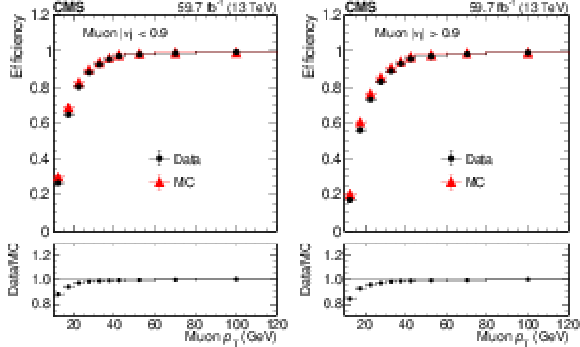
png pdf |
Figure 8:
Efficiency of the prompt-muon MVA selection as a function of the muon $ p_{\mathrm{T}} $ for muons with $ |\eta| < $ 0.9 (left) and $ |\eta| > $ 0.9 (right), for the 2018 data set with black dots and simulated DY events with red triangles. The vertical bars on the plots represent the statistical uncertainty of each measurement. |

png pdf |
Figure 8-a:
Efficiency of the prompt-muon MVA selection as a function of the muon $ p_{\mathrm{T}} $ for muons with $ |\eta| < $ 0.9 (left) and $ |\eta| > $ 0.9 (right), for the 2018 data set with black dots and simulated DY events with red triangles. The vertical bars on the plots represent the statistical uncertainty of each measurement. |
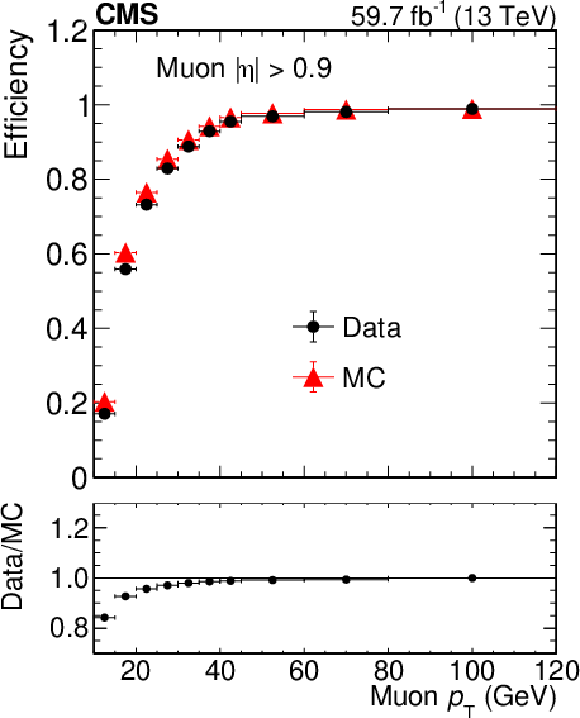
png pdf |
Figure 8-b:
Efficiency of the prompt-muon MVA selection as a function of the muon $ p_{\mathrm{T}} $ for muons with $ |\eta| < $ 0.9 (left) and $ |\eta| > $ 0.9 (right), for the 2018 data set with black dots and simulated DY events with red triangles. The vertical bars on the plots represent the statistical uncertainty of each measurement. |

png pdf |
Figure 9:
Distribution of data in the multijet control region as a function of the muon $ p_{\mathrm{T}} $ (upper left), $ \eta $ (upper central), segment compatibility (upper right), the DEEPJET B tagging score of the jet associated to the muon (lower left), the significance of the impact parameter (lower central) and the prompt-muon MVA score (lower right). The vertical bars on the dots represent the statistical uncertainty of each data point and the blue band, the uncertainty associated to the limited number of simulated events. |
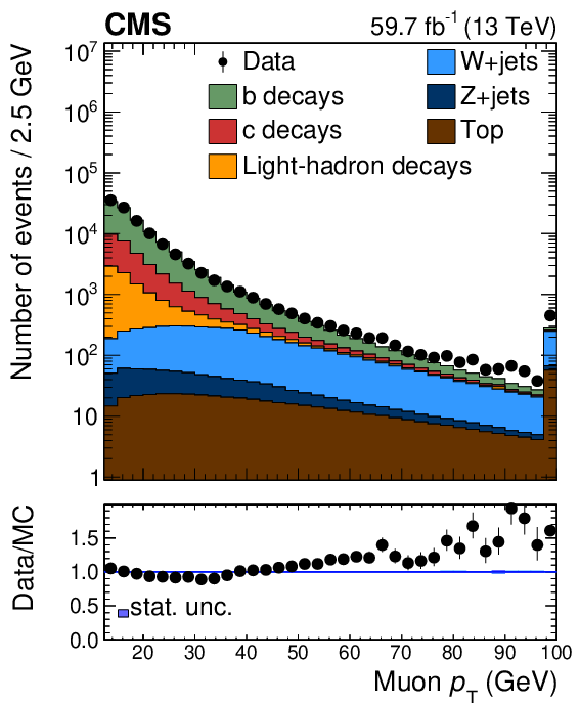
png pdf |
Figure 9-a:
Distribution of data in the multijet control region as a function of the muon $ p_{\mathrm{T}} $ (upper left), $ \eta $ (upper central), segment compatibility (upper right), the DEEPJET B tagging score of the jet associated to the muon (lower left), the significance of the impact parameter (lower central) and the prompt-muon MVA score (lower right). The vertical bars on the dots represent the statistical uncertainty of each data point and the blue band, the uncertainty associated to the limited number of simulated events. |
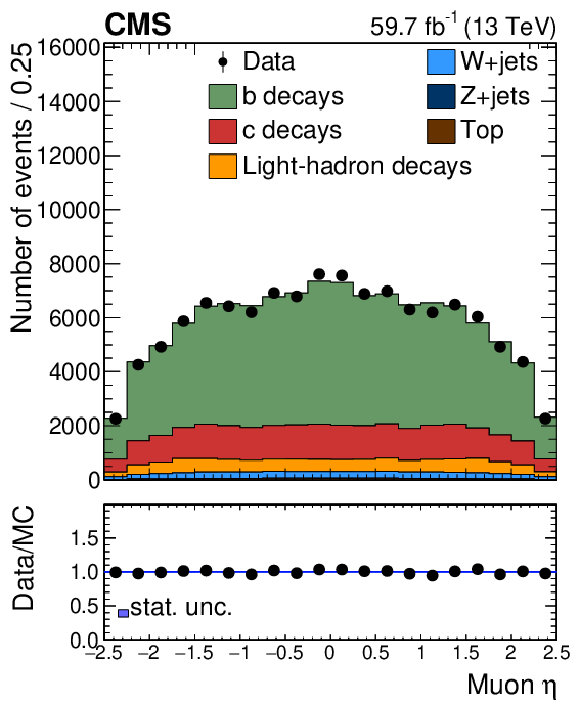
png pdf |
Figure 9-b:
Distribution of data in the multijet control region as a function of the muon $ p_{\mathrm{T}} $ (upper left), $ \eta $ (upper central), segment compatibility (upper right), the DEEPJET B tagging score of the jet associated to the muon (lower left), the significance of the impact parameter (lower central) and the prompt-muon MVA score (lower right). The vertical bars on the dots represent the statistical uncertainty of each data point and the blue band, the uncertainty associated to the limited number of simulated events. |
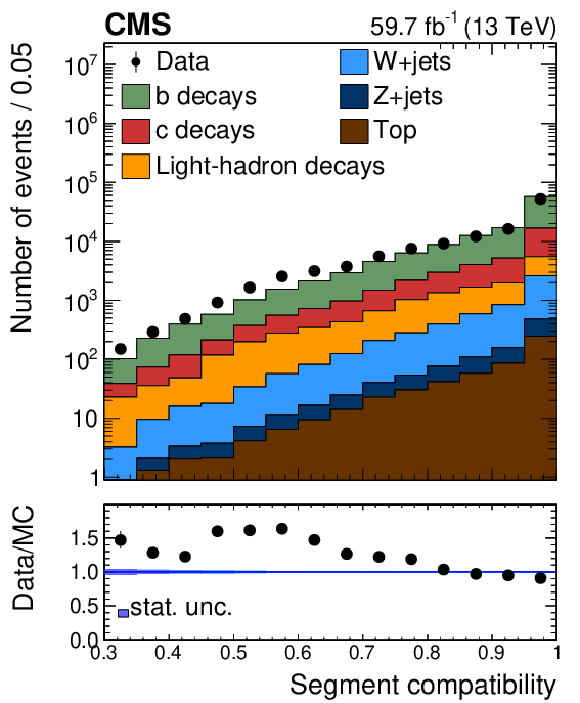
png pdf |
Figure 9-c:
Distribution of data in the multijet control region as a function of the muon $ p_{\mathrm{T}} $ (upper left), $ \eta $ (upper central), segment compatibility (upper right), the DEEPJET B tagging score of the jet associated to the muon (lower left), the significance of the impact parameter (lower central) and the prompt-muon MVA score (lower right). The vertical bars on the dots represent the statistical uncertainty of each data point and the blue band, the uncertainty associated to the limited number of simulated events. |

png pdf |
Figure 9-d:
Distribution of data in the multijet control region as a function of the muon $ p_{\mathrm{T}} $ (upper left), $ \eta $ (upper central), segment compatibility (upper right), the DEEPJET B tagging score of the jet associated to the muon (lower left), the significance of the impact parameter (lower central) and the prompt-muon MVA score (lower right). The vertical bars on the dots represent the statistical uncertainty of each data point and the blue band, the uncertainty associated to the limited number of simulated events. |
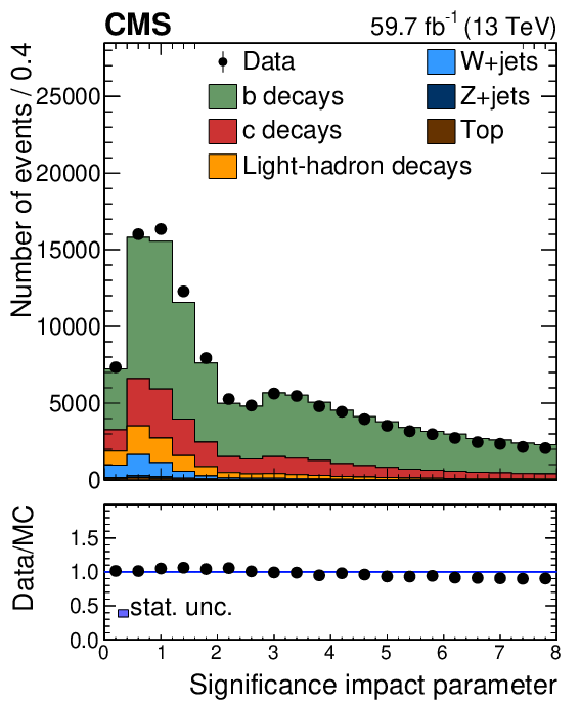
png pdf |
Figure 9-e:
Distribution of data in the multijet control region as a function of the muon $ p_{\mathrm{T}} $ (upper left), $ \eta $ (upper central), segment compatibility (upper right), the DEEPJET B tagging score of the jet associated to the muon (lower left), the significance of the impact parameter (lower central) and the prompt-muon MVA score (lower right). The vertical bars on the dots represent the statistical uncertainty of each data point and the blue band, the uncertainty associated to the limited number of simulated events. |

png pdf |
Figure 9-f:
Distribution of data in the multijet control region as a function of the muon $ p_{\mathrm{T}} $ (upper left), $ \eta $ (upper central), segment compatibility (upper right), the DEEPJET B tagging score of the jet associated to the muon (lower left), the significance of the impact parameter (lower central) and the prompt-muon MVA score (lower right). The vertical bars on the dots represent the statistical uncertainty of each data point and the blue band, the uncertainty associated to the limited number of simulated events. |

png pdf |
Figure 10:
Measurement of the nonprompt-muon rate of a prompt-muon MVA (blue dots) and mini-isolation (red triangles) selection as a function of $ p_{\mathrm{T}} $ for muons with $ |\eta| < $ 1.2 (left) and $ |\eta| > $ 1.2 (right) for the 2018 data set and simulated DY events. |

png pdf |
Figure 10-a:
Measurement of the nonprompt-muon rate of a prompt-muon MVA (blue dots) and mini-isolation (red triangles) selection as a function of $ p_{\mathrm{T}} $ for muons with $ |\eta| < $ 1.2 for the 2018 data set and simulated DY events. |
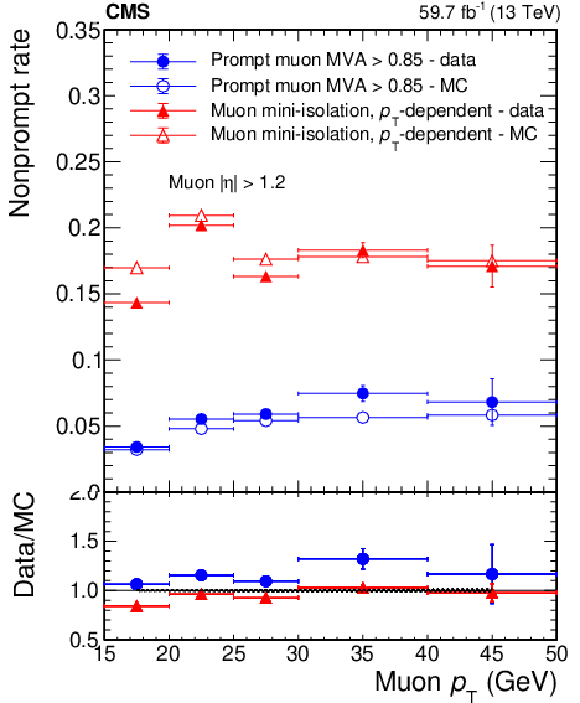
png pdf |
Figure 10-b:
Measurement of the nonprompt-muon rate of a prompt-muon MVA (blue dots) and mini-isolation (red triangles) selection as a function of $ p_{\mathrm{T}} $ for muons with $ |\eta| > $ 1.2 for the 2018 data set and simulated DY events. |
| Summary |
| A correct identification of the leptons is crucial in many precision measurements and searches to suppress the otherwise overwhelming background and as an indicator of interesting physical processes. Two multivariate analyses were developed for highly efficient muon identification and isolation. The first one, the muon MVA ID, is trained to distinguish muons produced promptly in heavy gauge boson decays as well as muons from $ \tau $ lepton and heavy-flavour hadron decays, from background muons produced in light-hadron decays (pions or kaons) or other spurious signatures in the detector that could be misreconstructed as muons. The discriminator is presented as an alternative to the standard cut-based identification criteria and could be used for high-efficiency working points. The second one, the prompt-muon MVA, selects isolated muons from W, Z, Higgs bosons, and $ \tau $ lepton decays to reduce the contamination from nonisolated muons arising in heavy-flavour hadron decays. Their performances are measured in proton-proton collisions recorded by the CMS experiment during 2018 and compared to simulation. The performance of the muon MVA ID improves significantly that of the cut-based ID and the prompt-muon MVA achieves a factor 2--3 times smaller nonprompt-muon rates than the mini-isolation selection. |
| References | ||||
| 1 | CMS Collaboration | The CMS experiment at the CERN LHC | JINST 3 (2008) S08004 | |
| 2 | CMS Collaboration | Performance of the CMS muon detector and muon reconstruction with proton-proton collisions at $ \sqrt{s}= $ 13 TeV | JINST 13 (2018) P06015 | CMS-MUO-16-001 1804.04528 |
| 3 | CMS Collaboration | Measurement of the Higgs boson production rate in association with top quarks in final states with electrons, muons, and hadronically decaying tau leptons at $ \sqrt{s}= $ 13 TeV | EPJC 81 (2021) 378 | CMS-HIG-19-008 2011.03652 |
| 4 | CMS Collaboration | Evidence for associated production of a Higgs boson with a top quark pair in final states with electrons, muons, and hadronically decaying $ \tau $ leptons at $ \sqrt{s}= $ 13 TeV | JHEP 08 (2018) 066 | CMS-HIG-17-018 1803.05485 |
| 5 | CMS Collaboration | Observation of $ {{\mathrm{t}\overline{\mathrm{t}}} \mathrm{H}} $ production | PRL 120 (2018) 231801 | CMS-HIG-17-035 1804.02610 |
| 6 | CMS Collaboration | Measurements of the electroweak diboson production cross sections in proton-proton collisions at $ \sqrt{s}= $ 5.02 TeV using leptonic decays | PRL 127 (2021) 191801 | CMS-SMP-20-012 2107.01137 |
| 7 | CMS Collaboration | Measurement of the inclusive and differential $ {\mathrm{W}\mathrm{Z}} $ production cross sections, polarization angles, and triple gauge couplings in $ {\mathrm{p}\mathrm{p}} $ collisions at $ \sqrt{s}= $ 13 TeV | JHEP 07 (2022) 032 | CMS-SMP-20-014 2110.11231 |
| 8 | CMS Collaboration | Measurements of the $ {\mathrm{p}\mathrm{p}\to\mathrm{W}\mathrm{Z}} $ inclusive and differential production cross section and constraints on charged anomalous triple gauge couplings at $ \sqrt{s}= $ 13 TeV | JHEP 04 (2019) 122 | CMS-SMP-18-002 1901.03428 |
| 9 | CMS Collaboration | Search for electroweak production of charginos and neutralinos in proton-proton collisions at $ \sqrt{s}= $ 13 TeV | JHEP 04 (2022) 147 | CMS-SUS-19-012 2106.14246 |
| 10 | CMS Collaboration | Observation of four top quark production in proton-proton collisions at $ \sqrt{s}= $ 13 TeV | Submitted to PLB | CMS-TOP-22-013 2305.13439 |
| 11 | CMS Collaboration | Measurement of properties of $ {\mathrm{B}_{s}^{0}\to\mu^{+}\mu^{-}} $ decays and search for $ {{\mathrm{B}^0}\to\mu^{+}\mu^{-}} $ with the CMS experiment | JHEP 04 (2020) 188 | CMS-BPH-16-004 1910.12127 |
| 12 | CMS Collaboration | Performance of the CMS Level-1 trigger in proton-proton collisions at $ \sqrt{s}= $ 13 TeV | JINST 15 (2020) P10017 | CMS-TRG-17-001 2006.10165 |
| 13 | CMS Collaboration | The CMS trigger system | JINST 12 (2017) P01020 | CMS-TRG-12-001 1609.02366 |
| 14 | CMS Collaboration | CMS luminosity measurement for the 2018 data-taking period at $ \sqrt{s}= $ 13 TeV | CMS Physics Analysis Summary, 2019 CMS-PAS-LUM-18-002 |
CMS-PAS-LUM-18-002 |
| 15 | CMS Collaboration | Precision luminosity measurement in proton-proton collisions at $ \sqrt{s}= $ 13 TeV in 2015 and 2016 at CMS | EPJC 81 (2021) 800 | CMS-LUM-17-003 2104.01927 |
| 16 | CMS Collaboration | Performance of the CMS muon trigger system in proton-proton collisions at $ \sqrt{s}= $ 13 TeV | JINST 16 (2021) P07001 | CMS-MUO-19-001 2102.04790 |
| 17 | J. Alwall et al. | The automated computation of tree-level and next-to-leading order differential cross sections, and their matching to parton shower simulations | JHEP 07 (2014) 079 | 1405.0301 |
| 18 | J. Alwall et al. | Comparative study of various algorithms for the merging of parton showers and matrix elements in hadronic collisions | EPJC 53 (2008) 473 | 0706.2569 |
| 19 | S. Alioli, P. Nason, C. Oleari, and E. Re | A general framework for implementing NLO calculations in shower Monte Carlo programs: the POWHEG box | JHEP 06 (2010) 043 | 1002.2581 |
| 20 | S. Frixione, P. Nason, and C. Oleari | Matching NLO QCD computations with parton shower simulations: the POWHEG method | JHEP 11 (2007) 070 | 0709.2092 |
| 21 | P. Nason | A new method for combining NLO QCD with shower Monte Carlo algorithms | JHEP 11 (2004) 040 | hep-ph/0409146 |
| 22 | NNPDF Collaboration | Parton distributions from high-precision collider data | EPJC 77 (2017) 663 | 1706.00428 |
| 23 | T. Sjöstrand et al. | An introduction to PYTHIA8.2 | Comput. Phys. Commun. 191 (2015) 159 | 1410.3012 |
| 24 | P. Skands, S. Carrazza, and J. Rojo | Tuning PYTHIA8.1: the Monash 2013 tune | EPJC 74 (2014) 3024 | 1404.5630 |
| 25 | CMS Collaboration | Extraction and validation of a new set of CMS PYTHIA8 tunes from underlying-event measurements | EPJC 80 (2020) 4 | CMS-GEN-17-001 1903.12179 |
| 26 | R. Frederix and S. Frixione | Merging meets matching in MC@NLO | JHEP 12 (2012) 061 | 1209.6215 |
| 27 | GEANT4 Collaboration | GEANT 4---a simulation toolkit | NIM A 506 (2003) 250 | |
| 28 | R. Fr \"u hwirth | Application of Kalman filtering to track and vertex fitting | NIM A 262 (1987) 444 | |
| 29 | CMS Collaboration | Description and performance of track and primary-vertex reconstruction with the CMS tracker | JINST 9 (2014) P10009 | CMS-TRK-11-001 1405.6569 |
| 30 | CMS Collaboration | Performance of the reconstruction and identification of high-momentum muons in proton-proton collisions at $ \sqrt{s}= $ 13 TeV | JINST 15 (2020) P02027 | CMS-MUO-17-001 1912.03516 |
| 31 | CMS Collaboration | Technical proposal for the Phase-II upgrade of the Compact Muon Solenoid | CMS Technical Proposal CERN-LHCC-2015-010, CMS-TDR-15-02, 2015 CDS |
|
| 32 | CMS Collaboration | Particle-flow reconstruction and global event description with the CMS detector | JINST 12 (2017) P10003 | CMS-PRF-14-001 1706.04965 |
| 33 | M. Cacciari, G. P. Salam, and G. Soyez | The anti-$ k_{\mathrm{T}} $ jet clustering algorithm | JHEP 04 (2008) 063 | 0802.1189 |
| 34 | M. Cacciari, G. P. Salam, and G. Soyez | FASTJET user manual | EPJC 72 (2012) 1896 | 1111.6097 |
| 35 | M. Cacciari, G. P. Salam, and G. Soyez | The catchment area of jets | JHEP 04 (2008) 005 | 0802.1188 |
| 36 | M. Cacciari and G. P. Salam | Pileup subtraction using jet areas | PLB 659 (2008) 119 | 0707.1378 |
| 37 | CMS Collaboration | Jet energy scale and resolution in the CMS experiment in $ {\mathrm{p}\mathrm{p}} $ collisions at 8 TeV | JINST 12 (2017) P02014 | CMS-JME-13-004 1607.03663 |
| 38 | CMS Collaboration | Performance summary of AK4 jet b tagging with data from proton-proton collisions at 13 TeV with the CMS detector | CMS Detector Performance Note CMS-DP-2023-005, 2023 CDS |
|
| 39 | E. Bols et al. | Jet flavour classification using \textscDeepJet | JINST 15 (2020) P12012 | 2008.10519 |
| 40 | CMS Collaboration | Performance of electron reconstruction and selection with the CMS detector in proton-proton collisions at $ \sqrt{s}= $ 8 TeV | JINST 10 (2015) P06005 | CMS-EGM-13-001 1502.02701 |
| 41 | CMS Collaboration | Search for supersymmetry in $ {\mathrm{p}\mathrm{p}} $ collisions at $ \sqrt{s}= $ 13 TeV in the single-lepton final state using the sum of masses of large-radius jets | JHEP 08 (2016) 122 | CMS-SUS-15-007 1605.04608 |
| 42 | A. Prinzie and D. Van den Poel | Random multiclass classification: Generalizing random forests to random MNL and random NB | in Proc. 18th International Conference on Database and Expert Systems Applications (DEXA ): Regensburg, Germany, 2007 link |
|
| 43 | F. Pedregosa et al. | Scikit-learn: Machine learning in Python | J. Mach. Learn. Res. 12 (2011) 2825 | |
| 44 | H. Voss, A. Höcker, J. Stelzer, and F. Tegenfeldt | TMVA, the toolkit for multivariate data analysis with ROOT | in Proc. 11th Int. Workshop on Advanced Computing and Analysis Techniques in Phys. Research (ACAT ): Amsterdam, The Netherlands, 2017 [PoS (ACAT) 040] |
physics/0703039 |
| 45 | CMS Collaboration | Measurements of inclusive W and Z cross sections in $ {\mathrm{p}\mathrm{p}} $ collisions at $ \sqrt{s}= $ 7 TeV | JHEP 01 (2011) 080 | CMS-EWK-10-002 1012.2466 |
| 46 | CMS Collaboration | Observation of single top quark production in association with a Z boson in proton-proton collisions at $ \sqrt{s}= $ 13 TeV | PRL 122 (2019) 132003 | CMS-TOP-18-008 1812.05900 |
| 47 | CMS Collaboration | Measurement of the cross section of top quark-antiquark pair production in association with a W boson in proton-proton collisions at $ \sqrt{s}= $ 13 TeV | JHEP 07 (2023) 219 | CMS-TOP-21-011 2208.06485 |
| 48 | CMS Collaboration | Measurement of top quark pair production in association with a Z boson in proton-proton collisions at $ \sqrt{s}= $ 13 TeV | JHEP 03 (2020) 056 | CMS-TOP-18-009 1907.11270 |
| 49 | CMS Collaboration | Inclusive and differential cross section measurements of single top quark production in association with a Z boson in proton-proton collisions at $ \sqrt{s}= $ 13 TeV | JHEP 02 (2022) 107 | CMS-TOP-20-010 2111.02860 |

|
Compact Muon Solenoid LHC, CERN |

|

|

|

|

|

|